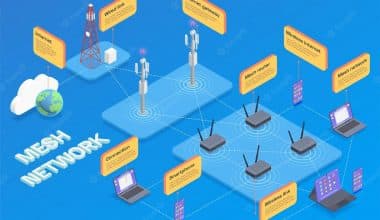As more businesses migrate to the cloud, having an enterprise VoIP phone number has become critical for running a modern organization. It works just like a conventional business phone line, allowing you to hold conference calls, send SMS messages to clients, and more. VoIP technology, in general, and cloud-based virtual phone systems in particular, are changing business communications. Here is all you need to know about a VoIP and non-VoIP phone number and how it works.
What is a VoIP number?
VoIP (Voice over Internet Protocol) numbers are essentially virtual phone numbers. You use it just like a regular phone number, but VoIP numbers allow you to make phone calls via the Internet.
It means you can make VoIP calls from any device that can connect to the Internet (cell phone, computer, softphone, desk phone, you name it). The number is also not associated with any specific device or geographic area.
How Does VoIP Operate?
VoIP operates by routing calls over the internet. Unlike traditional phone service, which requires calls to be routed through the local phone company, VoIP phone service can be accessed via any broadband connection. VoIP uses this technology to route calls along the most efficient path.
VoIP also includes additional modes of communication, such as chat and text messaging. A company’s owner can choose VoIP phone numbers for its employees, even if they work from home.
A typical phone line is rendered obsolete by VoIP for both commercial and household use.
VoIP Phone Number vs Landline
The transmission mode of the two technologies is not the same. A VoIP phone number is not tied to a specific location, whereas a traditional phone number is.
Also, the underlying technologies are vastly different. A normal landline number is sent over copper phone lines. To make calls, a VoIP number uses data networks such as the Internet and internal company LANs (Local Area Networks).
How Can I Obtain a VoIP Phone Number?
- Choose a VoIP service provider.
- Examine your internet connection.
- Pick a VoIP plan that has the capabilities you require.
- Choose the devices you want to utilize.
- Sign up for your VoIP service.
VoIP phone service companies that offer VoIP service plans can supply you with a VoIP phone number. The majority of options are less expensive than a cellphone or traditional telephone service.
As a result, you can reduce your costs by up to 60% while still gaining access to many additional capabilities that only VoIP can give.
You most certainly already have phone numbers. They are compatible with VoIP. The Federal Communications Commission supports your right to do so (FCC). You have the right to port your phone number to any provider. This is known as number porting. Phone numbers can be ported from your cell phone, Google Voice, cable/telephone company, or even a competing VoIP service provider.
You can choose new numbers or use current ones. That is all up to you. For every plan, Nextiva includes free porting and setup. Plans for Nextiva’s business phone service begin at $20 per month.
If you’re ready to make the move to VoIP phone service, there are a few steps you’ll need to take to set up your virtual phone system. First, check to see if you have a good internet connection.
Then, select the VoIP subscription that best meets your company’s needs, confirm your VoIP phone numbers, and select optional VoIP devices. After that, you can immediately start utilizing your VoIP system on your computer or smartphone.
Why Should I Purchase a VoIP Number?
A VoIP phone system has various benefits that traditional phone systems do not. You’ll save money, have more flexibility, be more reliable, and have crystal-clear call quality.
#1. Lower price
VoIP numbers use your internet connection instead of a phone line. Even with the monthly fee, the cost is less than that of a regular phone system.
You also receive access to a slew of premium services as part of the monthly fee. This contains all of your favorite features, such as an auto-attendant, phone queuing, intelligent call forwarding, and one-click conference calls, that your company requires. In addition, you can receive a toll-free VoIP number for free.
#2. More easily accessible
To make calls, a VoIP phone system does not require a physical location. Its convenience stems from a consistent internet connection. This allows for conversation across the country or halfway around the world.
VoIP does not consume a lot of bandwidth. Even a slow 10MB connection can handle 100 calls at once. With developments in LTE technology, you can use your smartphone to reliably place and receive calls.
Although wired connections are preferable, a robust Wi-Fi signal should suffice.
#3. Greater adaptability
A VoIP network offers a great deal of flexibility. Adding numerous phones to an existing system is limited when using a private, internal phone network. You are only restricted by your bandwidth while utilizing a VoIP network, which allows you to handle hundreds of conversations while using several common broadband plans.
Another feature that makes VoIP phones versatile is their ability to work with any device. These will be compatible with desktops, tablets, and VoIP phones. Most VoIP phones include peripherals to help you operate more efficiently, such as corded or wireless headphones. If you absolutely must have a classic telephone, you may always retrofit it with an Analog Telephone Adapter (ATA).
An ATA enables traditional telephone equipment to be used on an all-digital VoIP network. It just works after you set it up.
#4. Improved voice quality
Voice quality would be better than a typical phone connection with a reliable internet connection and high bandwidth. What makes this possible?
VoIP employs cutting-edge sound compression technology known as “codecs” to digitally convert sound, remove fuzziness and static in the line, and transmit it over the internet. The G.722 codec offers double the bandwidth of an analog phone call, resulting in higher call clarity. This is how VoIP provides high-quality calls.
In the unusual case of restricted bandwidth, the call elegantly drops to regular quality without your intervention. That is done automatically. If you call someone through the standard phone system, the call will still sound good, but it may not be in full HD.
#5. Multiples devices
One of the most advantageous features is the ability to use several devices with a single virtual number. With a VoIP number assigned to a person rather than a location, users can take that number with them wherever they go and access their account from any device.
After logging in, customers can make calls using a VoIP-capable personal or business laptop, computer, or cell phone. If the user so desires, these virtual phones can also be configured to forward calls to various phone numbers.
Remember that with VoIP, you can always arrange the call routing any way you wish. If you want to route incoming calls to a sales team, all or some of their phones can ring at the same time.
The option to use different devices with a single phone number provides the user with unparalleled flexibility.
#6. Area code selection
Unlike traditional phones, you can select an area code for your VoIP phone number that is not inside your city or state. This feature enables an individual or business owner to call an area code of their choice without incurring long-distance charges.
This also means that business owners can get a local phone number to build credibility. This might be useful for firms with multiple locations. It can also be handy for people who want many local numbers to route to the same address.
But, if the phone’s area code is for a certain city, such as Los Angeles, yet the VoIP phone is in New York, you’re effectively placing calls from Los Angeles. The location from which you make calls is no longer a concern.
#7. Number mobility
Phones are no longer fixed. Formerly, whenever you moved, the telephone company was contacted to change the new number at the new address. A service technician was usually required to come out and set up the new phones.
But, VoIP number portability is another option that can save any business owner time. The VoIP phone can use the same phone number regardless of location. All that is required is consistent IP connectivity.
Number portability means that if a company decides to adopt VoIP service, there is no need to change the phone number. It is not necessary to update the website, business cards, or marketing materials. Transfer your old phone number and carry on as usual!
#8. Toll-free telephone numbers
Toll-free numbers are no longer limited to huge corporations. With the usage of VoIP numbers, small and medium-sized enterprises can now receive toll-free calls. While it differs by provider, most will offer either free or very low-cost toll-free calling.
Toll-free calling can benefit a firm by removing the perception that it is limited to a single geographic area. Most of all, because various VoIP numbers can ring on different devices, these toll-free calls can be routed to your phone or computer.
How to Protect Yourself From VoIP Fraud
Despite the fact that VoIP technology is simple to use and inexpensive to maintain, this modern corporate phone solution is vulnerable to fraud.
The issue with VoIP number tricks is the difficulty in tracing the call. You may become a victim of VoIP fraud if you do not know what to look for or expect from a VoIP scammer.
Search for a VoIP supplier who offers call encryption via TLS and SRTP. This ensures the highest level of privacy and performance in every VoIP call.
Vishing (VoIP Phishing)
This is a sort of phone scam known as “voice phishing” or “VoIP phishing.” The deception begins with the appearance of a genuine caller ID with a valid phone number from a known and trusted source.
The scammer then attempts to persuade the unwary recipient to reveal essential personal and financial details.
Callers will frequently prey on two crucial characteristics to obtain the information they require: a person’s anxiety and financial security. This fraud is more effective because consumers often believe caller ID without realizing it can be manipulated.
How to Protect Yourself
VoIP phone fraud assaults are complex, making it difficult to distinguish between legal calls and attempts at identity theft. Here are a few measures to help you protect yourself from these intrusions:
- Never assume that every call comes from a good source, and remain up to date on the latest scams.
- Do not give out sensitive information over the phone unless you initiate the call.
- Security experts recommend changing your login credentials for all devices once a month.
- Never call phone numbers provided in unsolicited emails.
- If you are unsure who is calling, allow the caller to leave a message on your voicemail.
The good news is that successful VoIP fraud assaults are quite uncommon. You must be watchful against the threat or risk accidentally leaking your customer list.
How Can I Determine Who Owns a Phone Number If It’s a VoIP Call?
VoIP phones have become the standard for all enterprises worldwide. The convenience of being able to call anyone on the globe via the internet just cannot be beaten. Yet, while using VoIP for calls, there is a typical problem. How can you track down the owners of unidentifiable numbers?
When anonymous callers dial your VoIP number, you only see their caller ID. This absence of information can make it difficult to determine who is phoning your workplace phones. Is it a client or a spam caller who acquired your phone number? As a result, the problem of having to trace the number to the owner to find out how to handle it arises. When it comes to VoIP conversations, thankfully, there are several methods for tracing the owner of a number.
#1. VoIP Service Provider
The VoIP service provider is one approach to tracking down the owner of an unidentified VoIP number. All you have to do is write down the caller ID and the time of the call. Afterward, call your VoIP provider and supply the required details. They will be able to locate the owner of that phone number on your behalf. There is, however, one flaw with this strategy. The caller you’re looking for must have a registered caller ID or an IP address that they use for calls. It is more difficult to track them if they used a third party or a phony IP address to make the call.
#2. Reverse Phone Detective
This strategy makes use of many online programs to track down the owner of the phone line. There are various free reverse phone detectives available online. Typically, you merely need to enter the caller ID into a search engine to find the owner in a matter of seconds. Internet reverse searches are not just for VoIP. You can even use them to track landline calls that just display a number.
#3. Application Of Hardphone Or Softphone Packet Analyzers
A packet analyzer can be used to trace a VoIP number when connected to a proxy or server and using a Session Initiation Protocol (SIP) hardphone or softphone. It simply depends on whether you are connected through a proxy or a server.
Hardphones
To filter for hardphone IP and SIP, utilize the packet analyzer on your local network or server. You can trace the number manually if you have access to an Internet Telephony Service Provider (ITSP) Server by downloading a Secure Shell (SSH) client and issuing a trace command.
Softphones
A packet analyzer (such as Wireshark) must be installed on the device when using a softphone. You can use them to apply a SIP filter to your calls. To effectively apply the filter, select the “FROM” field from the invite packet choice. Putting this up will show you the IP address and name of the person who made the call.
#4. Changing Your device To Show VoIP Caller ID Name
When you have the original number, tracing the owner of a VoIP number becomes much easy. Most systems, however, do not display the complete number. VoIP numbers are made up of two parts:
The first is the caller ID, which is the number you see on all ordinary calls.
The second is the caller ID name (CNAM), which is not displayed by most phone terminals.
To obtain the complete number, you must configure your phone to display both the ID name and the CNAM.
Fortunately, there are various services, such as CallerID.com, that walk you through the process of configuring your smartphone to display the whole number. They demonstrate how to create an external query to add it to the database, which changes your phone to display both the ID name and the CNAM. The query type can be system-related (SIP/SS7, for example) or Json/Ajax. A query for said number would be simple to create for people with programming expertise. Once implemented, caller ID names would be returned as long as they were in the database.
#5. Application Of The VoIP Address Domain
A VoIP Address is typically in one of the following formats: 1234@voip.domain.tld, 5678@sample.com, 1234@176.42.127, and so on. Your phone records all incoming calls. Either as the mapped number or as the VoIP address shown above. You can easily trace the IP address provided back to the phone that originally called you using the domain name.
You can eventually trace any call, but how you do so differs. It all comes down to what you have access to, and you now have a better knowledge of what you can use. You have all of the ways listed above, but keep in mind that if there is a major scenario, the authorities may utilize other methods to track these communications.
What Is A Non-VoIP Phone Number?
Service providers supply consumers with non-VoIP numbers, often known as SIM numbers or fixed numbers. These numbers work without an internet connection. Numbers without VoIP are geographically limited. A SIM card from an African ISP will not work in the UK. Roaming can help with this, but it can be costly. But, because our number providers are there, we can give such numbers and they can accept messages from local services. Because these numbers are not roaming, they are not subject to geographical limits imposed by service providers.
How can I get a non-VoIP phone number for SMS verification?
The answer to this question is straightforward. Simply visit the websites that supply these numbers. Sadly, many of them are swindlers or resellers, and the number you purchased may already be in use. And because our purpose is to avoid fraud in your direction, we provide our services. SMS-MAN allows you to purchase a non-voip number and successfully register for the service in which you intend to create an account. Using a non-voip number also helps to prevent identity theft because the number is not linked to your personal data. In this article, we’ll show you how simple and quick it is to obtain a non-voip number.
Is VOIP a Real Phone Number?
A VoIP number is a legitimate phone number that operates through an internet connection. Voice Over IP phone numbers is assigned to users rather than actual locations.
Can I Get VoIP Number On Cell Phone?
You can use your VoIP number from any location by downloading a VoIP phone app that works on any mobile device or desktop computer.
Do VoIP Phones Need A SIM Card?
VoIP calls are not service provider reliant and do not require a SIM card.
How Do VoIP Phones Connect?
Voice over IP is a technology that turns your voice into a digital signal, compresses it, and sends it over the internet. The call is set up between all participants by a VoIP service provider. The digital data is then decompressed at the receiving end into the sound you hear through your smartphone or speakerphone.
To Summarize
With VoIP, you get exceptional value regardless of the numbers you choose. Telephone and cable companies just cannot compete with the features and capabilities that VoIP offers company owners.
And it’s not just about the money. Pick up the phone and dial the helpline. How long do you have to wait on hold? How well-informed and friendly is the staff? These considerations are critical because you do not have all day to worry about your phone system.
Related Articles
- The Top 10 VOIP BUSINESS PHONE SYSTEMS in 2023 (Updated)
- BEST BUSINESS PHONE SYSTEMS: 2023 Best Business Phone System Reviews (Updated)
- CLOUD-BASED PHONE SYSTEMS FOR SMALL BUSINESS in 2023 (Updated)
- 7+ Best BUSINESS PHONE SYSTEMS INTERNET in 2023






